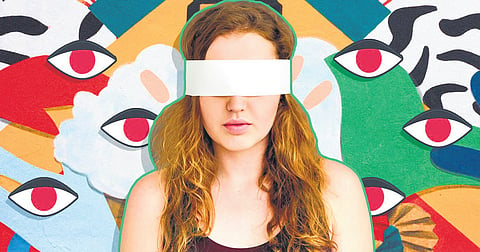Aphantasia: Drawing a blank
Last October, writer John Green, known for writing the bestseller ‘The Fault in Our Stars’, threw a peculiar gauntlet on social media. He posted an image of five heads thinking about an apple. In each image, the apple was shown in different degrees of clarity. The last image was completely blank. So what was it? Green shared, “It’s baffling to me that some of y’all see stuff in your mind. You SEE it? The way your eyes see? I always thought “visualise” meant thinking of the words/ideas/feelings associated with a thing, not actual visuals.” He confessed that in his mind’s eye, there was no apple—it was a plain slate.
Corporate professional Rohit Dhamankar's case can be best exemplified by Sherlock Holmes's aphorism, "You see, but do not observe." Replace observe with imagine, and you get Dhamankar's dilemma. During a meditation retreat he felt blankness blanket him. In a detailed LinkedIn post, he recalled, “I was with around 100 people on the weekend. When the teacher asked us to visualise certain geometric shapes, I heard people asking questions from various corners of the room on the colour of the object, the colour of the borders and orientation. In my mind was a wonderful grey-dark screen. I decided to go on Google and discovered I had Aphantasia—"Being blind in the mind’s eye.”
Who is affected by aphantasia?
Research suggests that there are vast differences between aphantasics. They can have a blind and a deaf mind, or a blind and a tasteless mind.
This condition is estimated to affect about 3.9 per cent of world population. The earliest documentation was done in 1880 by Sir Francis Galton, British eugenist and the creator of behavioural genetics. But it wasn’t until 2015 that Adam Zeman, from the University of Exeter, published the first case report on aphantasia. He had stumbled upon it by pure chance, when a client lost the ability of mental visualisation after a neurosurgery, prompting Zeman to study the phenomenon.
Dr Rajesh Kumar, senior neurologist at Prayag Hospitals Group, explains the condition in detail: “It’s characterised by the inability to voluntarily visualise images. Aphants typically cannot summon images in their mind’s eye, even though they can recognise and understand visual information through other senses. This condition varies in severity among affected individuals, though its causes have drawn a blank. Some people with aphantasia may still be able to dream visually, while others cannot.”
How to diagnose the condition?
Diagnosis is mostly done after individuals report to their doctors that they cannot visualise images. Tests include imagining specific scenarios or objects and describing what they see in their mind’s eye. Questionnaires, surveys and an FMRI (Functional Magnetic Resonance Imaging) test may also display different brain patterns.
Dr Kumar further explains that there are two types of aphantasia, constitutional and acquired. The first is present from birth or early childhood and is a fundamental aspect of their cognitive makeup. The second may occur due to trauma or neurological condition that happens later in life. The reasons are many: certain kinds of brain injuries, strokes, neurological events, severe anxiety or depression. But don't make the mistake that aphants are easy roll overs: most of them are strong and resilient when faced with anxiety provoking situations,” explains Dr Kumar.
Doctors believe that constitutional aphantasia cannot be treated, but acquired aphantasia stands a chance if its specific trigger can be identified and targeted. Excercises include engaging in mindfulness meditation to enhance awareness of non-visual sensory experiences and adopting stress reduction techniques like deep breathing practices to promote relaxation and well-being. Activities that stimulate the non-visual senses also help, such as listening to music or engaging in tactile hobbies. Exploring alternative memory techniques and seeking support from others with aphantasia through support groups or communities can also be beneficial. “While these strategies may help individuals with aphantasia, it’s important to recognise that they do not directly address the underlying condition itself,” summarises Dr Kumar.
Dr Ruttuja Karkhanis More, program chairperson, Department of Psychology, NMIMS University of Mumbai admits that there is no known cure for aphantasia. “Diagnosing the condition accurately is challenging. Aphantasia is considered a neurological condition but not a clinical or psychological disorder.” Fortunately, it isn’t a debilitating disease. Literature shows that people with aphantasia may have normal or even higher IQ. They excel in showing focus and concentration. “Many aphants look for careers in mathematics or chemistry."
The bright side of aphantasia
Ironically, aphantasia has a bright side. Hampering visualisation may help them cope with traumatic events quickly, because the negative memories do not haunt them constantly since they cant be recalled. The sad part is knowing they won't visualise the faces or physical characteristics of loved ones they have lost. Until the condition was diagnosed, millions of aphants have lived without even being aware of their peculiar condition. Imagine that!
Cognitive effects of aphantasia
● Difficulty with long-term memory
● Trouble remembering things in detail
● Inability to recall memories
● Poor work performance
●Increased risk of depression
● Limited ability to have dreams

